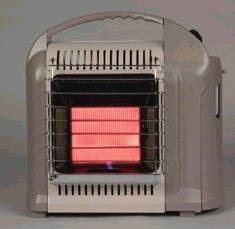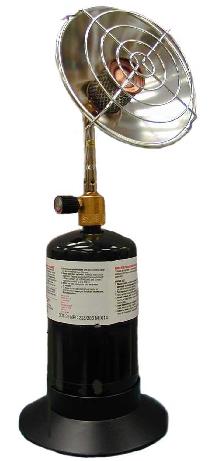As the weather turns colder and outdoor enthusiasts plan to go deer hunting, ice fishing, or camping, the U.S. Consumer Product Safety Commission (CPSC) is reminding consumers that there is a new generation of portable heaters with a safety device that can prevent the tragic loss of life due to carbon monoxide (CO) poisoning. The new heaters are equipped with an oxygen depletion sensor (ODS) and are safer to use when camping. If oxygen levels start to fall, this sensing technology automatically shuts down the heater before it can produce dangerous levels of CO.
Unlike earlier portable heaters that do not have an ODS and are intended for outdoor use only, the new ODS-equipped heaters are specifically designed for indoor use. They can be safely used inside tents, cabins, and campers, but it is essential that users comply with the manufacturers' instructions to ensure that there is adequate ventilation. CPSC still recommends shutting off any camping heater or lantern before going to sleep.
CPSC estimates that in 1998, the latest year for which data are available, 18 people died due to carbon monoxide poisoning associated with using portable propane heaters indoors. Many of these deaths could have been prevented if the victims had been using the new heaters. These deaths often occurred when consumers brought radiant camping heaters that used 1 lb. propane tanks (but did not have an ODS) inside tents, campers, and other vehicles, thus exposing themselves to high levels of CO.
"CPSC wants all consumers to know that there is a new generation of portable heaters that are safer to use when camping," said CPSC Chairman Hal Stratton. "Carbon monoxide poisoning is a silent killer that has taken the lives of many first-time and even experienced campers. The new, safer heaters prevent CO deaths by automatically shutting off the heater if oxygen levels start to fall."
CPSC worked closely with the American National Standards Institute (ANSI) Camping Equipment Subcommittee and the industry to develop and implement a new standard for 1 lb. portable heaters. The ODS technology on these heaters senses when the oxygen level in a tent or camper drops below 18 percent. If this occurs, the ODS closes the gas valve and shuts off the heater, preventing the production of dangerous levels of CO.
Consumers can find the safer heaters under various brands in major retail stores nationwide. Consumers need to ensure that they purchase portable heaters that meet the current standard. The new heaters can be identified by labels on the package that read in part, "Designed for Indoor Use," "Low Oxygen Automatic Shut-Off System," and "Oxygen Depletion Sensor" or by a star with the words "CSA 4.98."
CO is a silent killer, so CPSC has developed the following guidelines to prevent this colorless, odorless gas from poisoning you, your family or friends:
- New ODS-equipped heaters are intended for indoor use.
- Always follow the manufacturer's instructions for ventilation.
- Older generation heaters without an ODS are intended for outdoor use only and must never be used indoors.
- Do not use portable heaters that fail to meet the new standard in enclosed areas such as tents, campers, and other vehicles. This is especially important at high altitudes, where the risk of carbon monoxide poisoning is increased.
- Do not keep camping heaters and lanterns on while sleeping.
- Charcoal grills, camping lanterns, and gas generators also can cause carbon monoxide poisoning. To heat an interior area while camping, only use a camping heater that meets the new safety standard.
- Know the symptoms of carbon monoxide poisoning: headache, dizziness, weakness, nausea, vomiting, sleepiness, and confusion. Consumers who experience any of these symptoms should extinguish any possible source of CO and move to an area with fresh air.
- Carbon monoxide reduces the blood's ability to carry oxygen. Low blood oxygen levels can result in loss of consciousness and death. See a doctor if you or a member of your family develops cold or flu-like symptoms while camping. Carbon monoxide poisoning, which can easily be mistaken for a cold or flu, is often detected too late.
- Be aware that alcohol consumption and drug use increase the effects of carbon monoxide poisoning.
- Be aware that carbon monoxide is especially toxic to people with heart disease or blood or circulatory system problems, such as anemia. Fetuses, infants and the elderly are also more susceptible to CO poisoning.
- The surfaces of the heaters are extremely hot - always locate the heater away from traffic and combustible materials.


New Heaters with the "ODS" Technology

Older Heater (For Outdoor Use Only)
About the U.S. CPSC
The U.S. Consumer Product Safety Commission (CPSC) is charged with protecting the public from unreasonable risk of injury or death associated with the use of thousands of types of consumer products. Deaths, injuries, and property damage from consumer product-related incidents cost the nation more than $1 trillion annually. CPSC's work to ensure the safety of consumer products has contributed to a decline in the rate of injuries associated with consumer products over the past 50 years.
Federal law prohibits any person from selling products subject to a Commission ordered recall or a voluntary recall undertaken in consultation with the CPSC.
For lifesaving information:
- Visit CPSC.gov.
- Sign up to receive our e-mail alerts.
- Follow us on Facebook, Instagram @USCPSC and Twitter @USCPSC.
- Report a dangerous product or a product-related injury on www.SaferProducts.gov.
- Call CPSC’s Hotline at 800-638-2772 (TTY 301-595-7054).
- Contact a media specialist.
Please use the below phone number for all media requests.
Phone: (301) 504-7908
Spanish: (301) 504-7800
